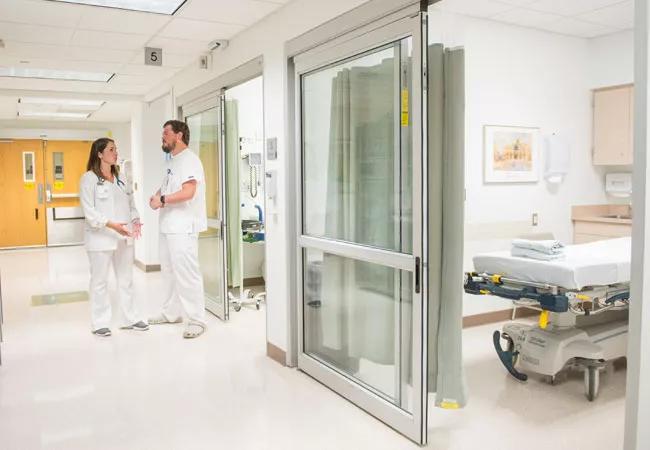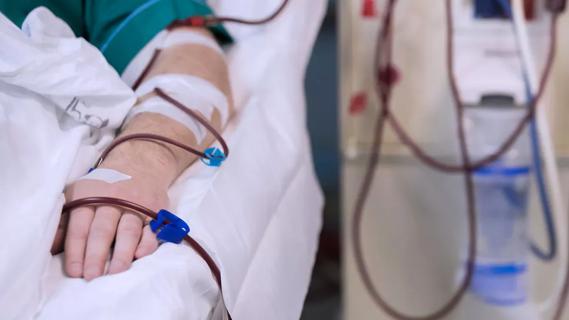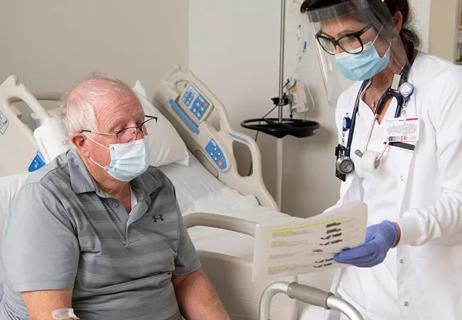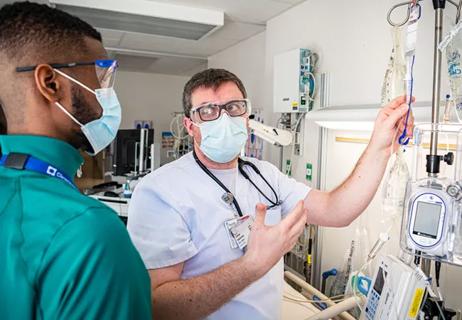New admission unit at Cleveland Clinic’s main campus alleviates gridlock

In spring 2018, Cleveland Clinic’s main campus opened an eight-bed inpatient Admission Unit within its Emergency Department (ED), designed to help alleviate issues faced by nearly all hospitals – extended patient length of stays and bottlenecks in the ED.
Cleveland Clinic is a non-profit academic medical center. Advertising on our site helps support our mission. We do not endorse non-Cleveland Clinic products or services. Policy
“We really want to make our ED as efficient as possible so patients spend the least amount of time there,” says Kimberly Hunter, DNP, MBA, RN, NEA-BC, Associate Chief Nursing Officer, main campus. “There are times when physicians decide to admit patients to the hospital, but they stay in the ED waiting for a bed to open up on a regular nursing unit. Having an Admission Unit allows patients to be transferred from the ED before moving to a medicine unit.”
The unit serves new admissions coming into the hospital from the ED under the medicine service line. It is staffed by an advanced practice provider, two full-time registered nurses, a nurse leader, a clinical technician and a health unit coordinator.
“Part of the beauty of the unit is that an advanced practice provider reviews the ED events and medical history of patients as soon as they come into the unit and writes the admission orders,” says Dr. Hunter. “Then nurses can immediately do an admission assessment, start the patient on different therapies and implement the ongoing plan of care – that all starts before the room on the regular nursing floor opens up.”
Cleveland Clinic Hillcrest Hospital piloted the concept of an admission unit near its ED. Opened in June 2017, the 10-bed West Center Admission Unit serves adults, including geriatric adults, requiring medical-surgical and progressive care with a variety of diagnoses, including cardiovascular, gastrointestinal, metabolic, neurological, orthopedic, pulmonary and renal conditions.
“After our admission unit’s implementation, patients’ ED length of stay was reduced by 30 minutes,” says Amy Berardinelli, DNP, RN, CPAN, NE-BC, Nurse Manager of the Surgery Center at Hillcrest Hospital.
Prior to opening the Admission Unit at Main Campus, several nurse leaders visited the Admission Unit at Hillcrest Hospital. “We asked questions about patient flow, processes and what’s important to start a unit,” says Hunter.
One of the key priorities was having a dedicated advanced practice provider present in the admission unit at main campus.
“Immediate attention to meeting patient treatment needs is critical to patient-centric care, and a primary early goal of moving patients from the ED environment,” says Josalyn Meyer, MSN, RN, NE-BC, Director of Nursing, Medicine & Endocrine and Metabolism Institute. “There’s no delay in caring for very ill patients, because we have a provider available at all times.”
Meyer says nurses had a seat at the table with all decisions and “it truly felt like nursing’s voice was heard.” For example, nurses offered suggestions on unit innovation, required equipment, hours of operation, different staffing patterns and collaboration with other disciplines, such as environmental services, transport and pharmacy.
The advantages of the admission unit extend beyond their initial purpose. “The original intent was to free up beds in the ED, but the trickle down benefits have been very impactful on patient experiences,” says Meyer. “Since patients aren’t waiting in the ED for their inpatient admission, and since their care plan is initiated earlier in the hospital stay and continues when they are transferred to the hospital unit, patients may be less anxious and they receive meals and chronic care medications more quickly.” Family members benefit by receiving communication about the care plan earlier in the process. And clinical unit nurses benefit by having the workload of an admission essentially removed, allowing nurses to focus on implementing the plan of care.
Anecdotal feedback from both patients and unit nurses has been positive, and Cleveland Clinic will track metrics on patient experience and nurse satisfaction. Preliminary numbers show the main campus unit is meeting its length of stay goal of three hours or less. At the end of June 2018, the average time from transfer into the admission unit and transfer to a medicine unit was three hours and four minutes.
“It’s so important that we have a good plan for the day because we are not open 24/7. It’s up to us to anticipate patient transfer out of the unit,” says Meyer. “We’ve not had a situation where the unit was ready to close and a patient was still occupying a bed, which speaks to our relationships and communication with fellow healthcare providers. The main campus admission unit is a well-oiled machine.”
There is discussion about extending the unit’s hours and adding more service lines, such as orthopaedics, digestive diseases and cardiovascular medicine.

Phone triage system reduces call backs and delays in care

New protocol reduces costs, increases patient and caregiver satisfaction

New options benefit caregivers, nursing units and patients

Nurses facilitate preoperative program to educate and prepare patients for ongoing care

Introduces at-home work and new patient screening tool

Health disparities, mental health and more

Ideas for approaches to prevention, response and more

Educating and developing generations of nurses